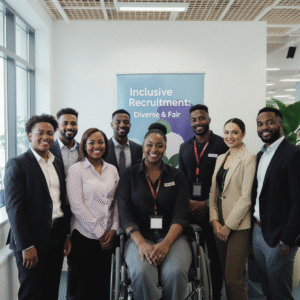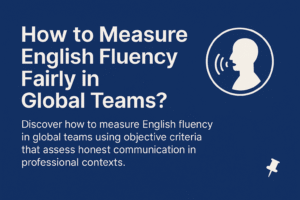Learn how to increase international recruitment efficiency through lower costs, more transparent processes, and data-driven English fluency assessments.
Boosting recruitment efficiency in a global context isn’t just an HR goal—it’s a strategic necessity.
International recruitment doubles the challenge: finding English-fluent, culturally aligned, technically qualified candidates within budget constraints. All this must happen without wasting resources on unproductive steps.
But where exactly are resources wasted in global recruitment? How can fluency assessments improve without burdening the team? Most importantly, how can international recruitment be structured to be efficient, scalable, and financially viable?
In this article, we’ll explore the main bottlenecks, essential tools like FluencyFlow, and best practices to revolutionize how your company selects talent globally.
Key Challenges for Efficient International Recruitment
Recruitment efficiency faces a tough test when crossing borders.
Recruiting globally isn’t merely about filling vacancies but about finding professionals who are fluent in the required language, capable of working in multicultural teams, and prepared for international company standards, all within tight deadlines and budgets.
The first obstacle is precisely fluency assessment. Many candidates present proficiency certificates or claim advanced skills in their resumes but struggle to maintain fluid conversations, especially in technical contexts.
This becomes even more critical when English is the operational language rather than just a general requirement.
Another key issue is the lack of standardized selection criteria. Global teams often employ different methods for interviewing and evaluating candidates, which can complicate fair comparisons and lead to inconsistent decisions across units.
Moreover, redundant steps, lengthy interviews, and repetitive processes drive up recruitment costs and time-to-hire.
Distance and cultural diversity also pose significant challenges. Conducting face-to-face interviews isn’t always feasible, and remote evaluations require reliable technology. Fair communication assessments must distinguish linguistic skills from regional accents to avoid unfair disqualification.
Where Recruitment Budgets Typically Get Wasted
One of the primary obstacles to global recruitment efficiency is wasting resources on ineffective steps.
In international recruitment, geographical, technological, and cultural barriers intensify budget waste.
Common budget leaks include:
- Poorly targeted screening allows unsuitable candidates to progress.
- Repeated interview stages with different interviewers asking identical questions.
- Universal testing before basic candidate validation.
- Unclear fluency assessment processes lead to costly hiring errors or wrongful disqualifications.
Imagine hiring a professional for an international relations role who later reveals intermediate English proficiency. The implications extend beyond financial costs, impacting reputation, productivity, and workload.
Prioritizing High-Value Stages
The rule here is clear: if a step doesn’t directly aid decision-making, review it.
In international recruitment, creating a funnel where stages are sorted by depth and impact is essential. This involves:
- Automated screening based on objective criteria like experience, education, and location.
- Fluency verification before technical or behavioural evaluations using an efficient tool.
- Strategic interviews focusing on company culture and job-specific challenges.
This approach ensures better filtering, dedicates resources to suitable candidates, and clarifies the purpose of each stage. For fluency assessments, objective, efficient methods are crucial for preventing bottlenecks and accelerating the process.
Strategic Use of Technology
Investing in technology doesn’t mean acquiring multiple platforms; instead, it means selecting those that genuinely benefit the acceleration of processes without sacrificing quality.
1. Artificial Intelligence for Resume Screening
AI can intelligently organize resumes, identifying patterns in experience, keywords, and cultural alignment. This frees HR teams to focus on strategic tasks, preventing good profiles from being overlooked due to workload.
2. Automated Managerial Alignment
Misalignment between HR and managers often leads to poor decisions. Collaborative software standardizes criteria, creates structured briefings, and documents expectations, minimizing rework and redundant meetings.
3. Fluency Assessment with FluencyFlow
Fluency assessment is one of the most critical yet overlooked areas in global recruitment. Depending on the role, oral fluency can be as vital as technical expertise.
FluencyFlow addresses this, enabling companies to assess candidates’ English fluency fairly, quickly, and at scale.
How FluencyFlow Works:
- Candidates record answers to practical, role-specific questions.
- AI evaluates response time, clarity, vocabulary, and fluency without penalizing regional accents.
- Results are presented in clear HR dashboards.
This saves team time, avoids subjective evaluations, and standardizes assessments, placing the right technology at the right stage.
Measuring the ROI of Each Stage
Improving recruitment efficiency isn’t only about applying tools—it’s understanding their purpose and tracking their impact.
Monitor indicators such as:
- Cost per international hire before and after process adjustments.
- Average hiring time.
- Interviews per hire (fewer interviews suggest higher funnel accuracy).
- Manager feedback regarding actual fluency of hires.
- Six-month retention rates to gauge hiring accuracy.
FluencyFlow generates historical reports demonstrating whether hires with higher fluency scores perform better, justifying tech investments with tangible data.
Conclusion
Modern international recruitment requires finding top global talent without wasting time, money, or opportunities.
This is achievable through structured processes, prioritizing valuable steps, and assessing competencies that truly impact performance.
Recruitment efficiency involves more than reviewing resumes—fluency assessment is a crucial turning point.
Adopting tools like FluencyFlow moves your recruitment away from subjective interviews towards reliable, scalable, data-driven decisions.
In a competitive global market, efficient recruitment blends human intelligence with evidence-based choices. Fluency, when accurately measured, has a significant impact on these choices.
Ready to test our AI-powered English fluency assessment tool? Click here to get started.




